Arch of Titus
The Arch of Titus (Italian: Arco di Tito; Latin: Arcus Titi) is a 1st-century AD honorific arch,[1] located on the Via Sacra, Rome, just to the south-east of the Roman Forum. It was constructed in c. 81 AD by the Emperor Domitian shortly after the death of his older brother Titus to commemorate Titus's official deification or consecratio and the victory of Titus together with their father, Vespasian, over the Jewish rebellion in Judaea.[2] The arch contains panels depicting the triumphal procession celebrated in 71 AD after the Roman victory culminating in the fall of Jerusalem,[2] and provides one of the few contemporary depictions of artifacts of Herod's Temple. It became a symbol of the Jewish diaspora, and the menorah depicted on the arch served as the model for the menorah used as the emblem of the state of Israel.[3]
| Arch of Titus | |
|---|---|
 The Arch of Titus, showing the "Spoils of Jerusalem" relief on the inside arch | |
| Location | X Palatium |
| Built in | c. AD 81 |
| Built by/for | Emperor Domitian |
| Type of structure | honorific arch |
| Related | Titus, Roman triumph, First Jewish–Roman War |
  Arch of Titus | |
The arch has provided the general model for many triumphal arches erected since the 16th century—perhaps most famously it is the inspiration for the Arc de Triomphe in Paris, France.[4]
History
Based on the style of sculptural details, Domitian's favored architect Rabirius, sometimes credited with the Colosseum, may have executed the arch. Without contemporary documentation, however, attributions of Roman buildings on basis of style are considered shaky.
The medieval Latin travel guide Mirabilia Urbis Romae noted the monument, writing: "the arch of the Seven Lamps of Titus and Vespasian; [where Moses' candlestick is having seven branches, with the Ark, at the foot of the Cartulary Tower"].[5][6]
During the Middle Ages, the Frangipani family added a second story to the vault, converting it into a fortified tower;[7] beam holes from the construction remain in the panels.[8] Pope Paul IV (papacy 1555–1559) made it the place of a yearly oath of submission.
It was one of the first buildings sustaining a modern restoration, starting with Raffaele Stern in 1817 and continued by Valadier under Pius VII in 1821, with new capitals and with travertine masonry, distinguishable from the original marble. The restoration was a model for the country side of Porta Pia.[7][9]
At an unknown date, a local ban on Jews walking under the arch was placed on the monument by Rome's Chief Rabbinate; this was rescinded on the foundation of the State of Israel in 1948, and at a Hanukkah event in 1997 the change was made public.[10][11][12] The arch was never mentioned in Rabbinic literature.[13]
Description
Architecture
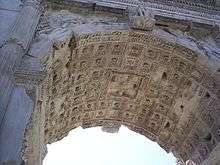
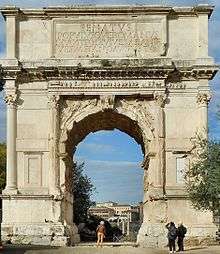
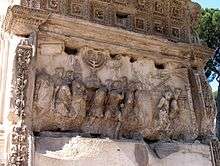

The arch is large with both fluted and unfluted columns, the latter being a result of 19th-century restoration.[14]
Size
The Arch of Titus measures: 15.4 meters (50 ft) in height, 13.5 meters (44 ft) in width, 4.75 meters (15.5 ft) in depth. The inner archway is 8.3 (27 ft) meters in height, and 5.36 (17.5 ft) in width. [15]
Decorative sculpture
The spandrels on the upper left and right of the arch contain personifications of victory as winged women. Between the spandrels is the keystone, on which there stands a female on the east side and a male on the west side.[14]
The soffit of the axial archway is deeply coffered with a relief of the apotheosis of Titus at the center. The sculptural program also includes two panel reliefs lining the passageway within the arch. Both commemorate the joint triumph celebrated by Titus and his father Vespasian in the summer of 71.
The south inner panel depicts the spoils taken from the Temple in Jerusalem. The golden candelabrum or Menorah is the main focus and is carved in deep relief.[16] Other sacred objects being carried in the triumphal procession are the Gold Trumpets, the fire pans for removing the ashes from the altar, and the Table of Shewbread.[14] These spoils were likely originally colored gold, with the background in blue.[14] In 2012 the Arch of Titus Digital Restoration Project discovered remains of yellow ochre paint on the menorah relief.[17]
The north inner panel depicts Titus as triumphator attended by various genii and lictors, who carry fasces. A helmeted Amazonian, Valour, leads the quadriga or four horsed chariot, which carries Titus. Winged Victory crowns him with a laurel wreath.[14] The juxtaposition is significant in that it is one of the first examples of divinities and humans being present in one scene together.[14] This contrasts with the panels of the Ara Pacis, where humans and divinities are separated.[14]
The sculpture of the outer faces of the two great piers was lost when the Arch of Titus was incorporated in medieval defensive walls.[14] The attic of the arch was originally crowned by more statuary, perhaps of a gilded chariot.[14] The main inscription used to be ornamented by letters made of perhaps silver, gold or some other metal.
Inscriptions
Original inscription

The original inscription is attached to the east side of the Arch. It is written in Roman square capitals and reads:
SENATVS
POPVLVSQVE·ROMANVS
DIVO·TITO·DIVI·VESPASIANI·F(ILIO)VESPASIANO·AVGVSTO
(Senatus Populusque Romanus divo Tito divi Vespasiani filio Vespasiano Augusto)[18], which means
"The Senate and the Roman people (dedicate this) to the deified Titus Vespasian Augustus, son of the deified Vespasian."[19]
1821 inscription
The opposite side of the Arch of Titus received new inscriptions after it was restored during the pontificate of Pope Pius VII by Giuseppe Valadier in 1821. The restoration was intentionally made in travertine to differentiate between the original and the restored portions.
The inscription reads:
INSIGNE · RELIGIONIS · ATQVE · ARTIS · MONVMENTVM
VETVSTATE · FATISCENS
PIVS · SEPTIMVS · PONTIFEX · MAX(IMVS)
NOVIS · OPERIBVS · PRISCVM · EXEMPLAR · IMITANTIBVS
FVLCIRI · SERVARIQVE · IVSSITANNO · SACRI · PRINCIPATVS · EIVS · XXIIII
(Insigne religionis atque artis, monumentum, vetustate fatiscens: Pius Septimus, Pontifex Maximus, novis operibus priscum exemplar imitantibus fulciri servarique iussit. Anno sacri principatus eius XXIV), which means
(This) monument, remarkable in terms of both religion and art,
had weakened from age:
Pius the Seventh, Supreme Pontiff,
by new works on the model of the ancient exemplar
ordered it reinforced and preserved.• In the 24th year of his sacred rulership. •
Architectural influence
Works modelled on, or inspired by, the Arch of Titus include, chronologically:
- Facade of the Basilica di Sant'Andrea di Mantova (1462) by Leon Battista Alberti[19]
- The Arc de Triomphe, Paris, France (1806)[19]
- The Soldiers' and Sailors' Arch, Brooklyn (1892)
- The Washington Square Arch, Manhattan by Stanford White (1892)[19]
- The Fusiliers' Arch, Dublin (1907)
- The National Memorial Arch, Valley Forge National Historical Park, Pennsylvania, by Paul Philippe Cret (1910)
- The India Gate, New Delhi, India, by Edward Lutyens (1921)[19]
Gallery
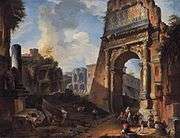 c.1740 by Giovanni Paolo Panini
c.1740 by Giovanni Paolo Panini_054.jpg) 1744 by Canaletto
1744 by Canaletto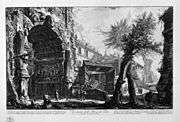 1748-74 by Giovanni Battista Piranesi
1748-74 by Giovanni Battista Piranesi 1839 by Constantin Hansen
1839 by Constantin Hansen
See also
- Related to the Jewish revolt
- First Jewish-Roman War
- Judaea Capta coinage
- List of artifacts significant to the Bible
- Menorah (Temple)
- Showbread
- Related to Roman triumph and the Arch
References
- It was not a triumphal arch; Titus's triumphal arch was in the Circus Maximus.
- "The Arch of Titus". exhibitions.kelsey.lsa.umich.edu. Retrieved 2017-07-06.
- Mishory, Alec. "Israel National Symbols: The State Emblem". Jewish Virtual Library. Retrieved 2014-07-30.
- Diana Rowell (23 August 2012). Paris: The 'New Rome' of Napoleon I. Bloomsbury Publishing. pp. 43–. ISBN 978-1-4411-2883-6.
- In English https://archive.org/stream/marvelsromeorap00nichgoog#page/n50/mode/2up; in Latin: "Arcus septem lucernarum Titi et Vespasiani, ubi est candelabrum Moysi cum arca habens septem brachia in piede turris cartulariae", Mirabilia Urbis Romae, page 4
- For a review of historical references to the Arch of Titus, see: Élisabeth Chevallier, Raymond Chevallier, Iter Italicum: les voyageurs français à la découverte de l'Italie ancienne, Les Belles Lettres, 1984, ISBN 9782251333106, pages 274–291
- A Let's Go City Guide: Rome, p. 76, Vedran Lekić, 2004; ISBN 1-4050-3329-0.
- De la Croix, Horst; Tansey, Richard G.; Kirkpatrick, Diane (1991). Gardner's Art Through the Ages (9th ed.). Thomson/Wadsworth. p. 232. ISBN 0-15-503769-2.
- The Buildings of Europe: Rome, page 33, Christopher Woodward, 1995; ISBN 0-7190-4032-9.
- Sotto l' arco di Tito la festa degli ebrei, la Repubblica, 23 December 1997. Accessed 27 July 2019.
- Festa di Channoukà: Celebrazione dei 50 anni dello Stato d'Israele presso l'Arco di Tito alla presenza delle autorità e della Comunità israelitica romana. On Radio Radicale website, 23 December 1997. Accessed 27 July 2019.
- Morton Satin, a division director at the Food and Agriculture Organization published an article in The Forward, stating that he had successfully "stirred up had triggered considerable deliberation within Rome's Jewish community" for a public end to the ban: Satin, Morton (2013-12-01). "One Man's Campaign Against the Arch of Titus — and How It Changed Italy's Jews". The Forward. Retrieved 2014-07-30.
According to an ancient ban placed on the monument by Rome's Jewish authorities, once a Jewish person walks under the arch, he or she can no longer be considered a Jew... the chief rabbi of Rome had told the Israeli Embassy that the original ban was no longer valid, since an independent State of Israel had been established. Unfortunately, no one who knew about the ban had ever been informed of its abrogation!
- Steven D. Fraade, The Temple as a Marker of Jewish Identity Before and After 70 CE: The Role of the Holy Vessels in Rabbinic Memory and Imagination, p. 246. "the Arch of Titus is never mentioned in rabbinic sources... there are several references to second-century rabbinic viewings of captured Temple objects in Rome"
- Artus, Paul (2006). Art and Architecture of the Roman Empire. Bellona Books. pp. 45–48. ISBN 978-0-9582693-1-5.
- "Arch of Titus, Rome - Building Info". Aviewoncities.com. Retrieved 2018-04-05.
- Ermengem, Kristiaan Van. "Arch of Titus, Rome". A View On Cities. Retrieved 2017-07-06.
- "Center for Israel Studies | Yeshiva University". Yu.edu. Retrieved 2018-04-05.
- CIL 6.945
- Dr. Jeffrey Becker. "The Arch of Titus". Khan Academy website. Retrieved 27 July 2019.
- "Arch of Titus". Smarthistory at Khan Academy. Retrieved December 19, 2012.
Further reading
- R. Ross Holloway. "Some Remarks on the Arch of Titus". L’antiquité classique. 56 (1987) pp. 183–191.
- M. Pfanner. Der Titusbogen. Mainz: P. von Zabern, 1983.
- L. Roman. "Martial and the City of Rome". The Journal of Roman Studies 100 (2010) pp. 1–30.
- "You searched for 'arch of titus'". Jewish Telegraphic Agency.
External links
| Library resources about Arch of Titus |
| Wikisource has original text related to this article: |
| Wikimedia Commons has media related to Arch of Titus. |
- Samuel Ball Platner, A Topographical Dictionary of Ancient Rome: Arch of Titus
- Arch of Titus History and photos
- YU-CIS: The Arch of Titus Digital Restoration Project
- One Man's Campaign Against the Arch of Titus — and How It Changed Italy's Jews, by Morton Satin
- The Arch of Titus history and photos
- High-resolution 360° Panoramas and Images of Arch of Titus | Art Atlas